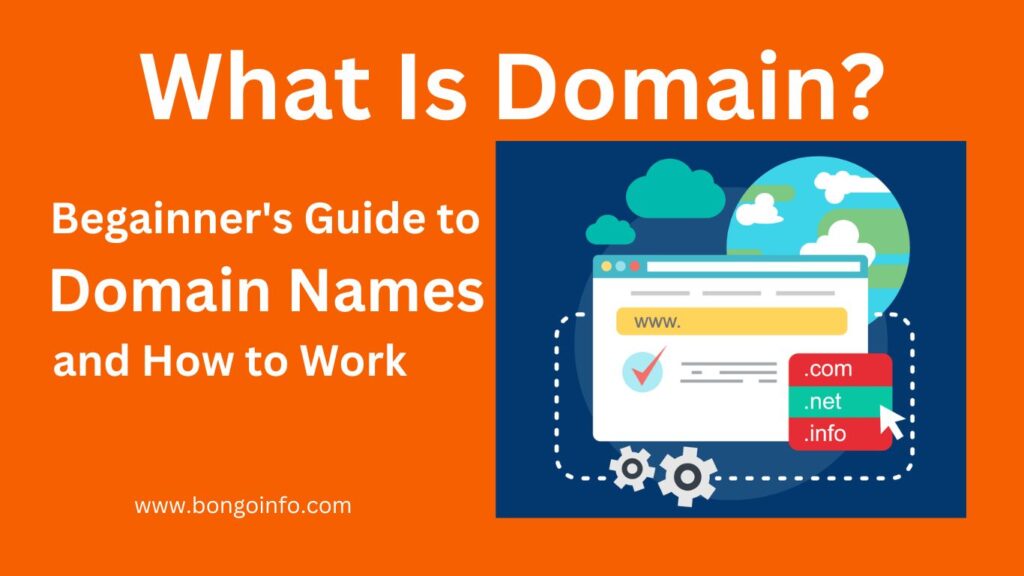What is Domain? Complete Guide for Beginners
A domain name is a unique address that identifies your website on the internet. It’s the address that your audience types into their web browser to access your site. For a blog website, choosing the right domain name is crucial because it plays a critical role in attracting visitors and building your online identity. In this article, we’ll explore the importance of having a domain name and tips for choosing the right one for your blog.

What is Domain?
A domain is a unique identifier on the internet that represents a specific website or group of websites. It’s the address that people type into their web browser to access a website. A domain name typically consists of two parts: a top-level domain (TLD) and a second-level domain (SLD). The TLD is the extension at the end of the domain name, such as .com, .org, .net, and so on. The SLD is the name that comes before the TLD and represents the specific website or organization. For example, in the domain name “www.example.com,” “example” is the SLD and “.com” is the TLD.
A domain name is crucial for establishing a website’s online presence and making it easily accessible to the public. When someone types a domain name into their web browser, it resolves to an IP address, which is the unique numerical identifier for the website’s server. In this way, a domain name acts as an alias for a website’s IP address, making it easier for people to remember and find the website.
Why is a Domain Name Important?
Branding: Your domain name is the first thing people see when they visit your blog website. A domain name that reflects your brand or niche can help you establish a strong online identity. A memorable and easy-to-spell domain name can also help you build brand recognition and trust with your audience.
Search Engine Optimization (SEO): A domain name that includes keywords related to your blog can improve your website’s search engine ranking. This can make it easier for people to find your site through search engines like Google, Yahoo, or Bing.
Professionalism: Having your own domain name instead of a free website builder’s subdomain, makes your blog look professional and credible. A custom domain name also makes it easier for your audience to remember your site and helps you establish your online presence.
Tips for Choosing the Right Domain Name for Your Blog
Keep it short and simple: A short and simple domain name is easy to remember and reduces the risk of typos when someone tries to visit your site.
Use keywords: If possible, include keywords related to your blog in your domain name. This can help improve your SEO and make it easier for people to find your site through search engines.
Make it memorable: A memorable domain name is more likely to be remembered by your audience and can help you establish a strong online identity.
Avoid using numbers and hyphens: Numbers and hyphens can be confusing and can reduce the readability and memorability of your domain name.
Choose a relevant TLD: The top-level domain (TLD) is the extension at the end of your domain name, such as .com, .org, .net, etc. Choose a TLD that is relevant to your blog. For example, if your blog is about a non-profit organization, .org is a better TLD choice.
Protect your brand: If you plan on expanding your blog in the future, consider registering similar domain names to protect your brand.
What are the 4 types of domain?
There are several types of domains, but the four most common ones are:
Top-Level Domains (TLDs): TLDs are the extensions at the end of a domain name, such as .com, .org, .net, and so on. TLDs are the highest level of domains and are managed by the Internet Corporation for Assigned Names and Numbers (ICANN).
Country-Code Top-Level Domains (ccTLDs): ccTLDs are two-letter TLDs that represent specific countries or territories, such as .uk for the United Kingdom, .jp for Japan, and so on.
Generic Top-Level Domains (gTLDs): gTLDs are TLDs that are not specific to a particular country or territory, such as .com, .info, and .name.
Second-Level Domains (SLDs): SLDs are the names that come before the TLD in a domain name and represent the specific website or organization. For example, in the domain name “www.example.com,” “example” is the SLD.
Each type of domain serves a different purpose and has its own set of requirements and restrictions. When choosing a domain name for a website, it’s important to consider the type of domain that best fits the needs of the website and the target audience.
How Do Domains Work?
Domains work by connecting a domain name to an IP address, which is a unique numerical identifier for a website’s server. When someone types a domain name into their web browser, the browser uses a domain name system (DNS) to resolve the domain name into its corresponding IP address. The browser then uses the IP address to connect to the website’s server and retrieve the content that is displayed in the browser.
A domain name is a way of making it easier for people to find and remember a website. An IP address is a series of numbers that can be difficult for people to remember, so domain names were introduced to provide a more human-friendly way of accessing websites.
When you register a domain name, you’re essentially reserving that domain name for a specific period of time (usually one or more years). During this time, the domain name is associated with your website, and visitors can access your website by typing the domain name into their web browser. You have the option to renew your domain registration when it expires, so that you can continue to use the domain name for your website.
Why Do I Need a Domain Name?
There are several reasons why you need a domain name for your website or online presence:
Branding: A domain name can help establish your brand and create a professional online presence. A memorable and easy-to-spell domain name can make it easier for people to find your website and remember your brand.
Credibility: Having a domain name can increase your credibility and give your website a more professional look. It shows that you’re serious about your online presence and have taken the time to invest in a domain name.
Search engine optimization (SEO): Having a domain name can help with SEO by making it easier for search engines to crawl and index your website. Having a keyword-rich domain name can also improve your search engine ranking.
Custom email addresses: Having a domain name allows you to create custom email addresses, such as [email protected], which can make your business or personal communications appear more professional.
Ownership: A domain name gives you ownership of a unique online identity. This can help prevent others from using a similar name or trademark for their own purposes.
Flexibility: Having a domain name allows you to choose where your website is hosted and who provides your web hosting services. This gives you more control and flexibility over your website and online presence.
What is domain and its uses?
A domain is a unique identifier on the internet that represents a specific website or group of websites. It’s the address that people type into their web browser to access a website. A domain name typically consists of two parts: a top-level domain (TLD) and a second-level domain (SLD). The TLD is the extension at the end of the domain name, such as .com, .org, .net, and so on. The SLD is the name that comes before the TLD and represents the specific website or organization.
What’s a domain in a website?
In the context of websites, a domain refers to a unique, memorable address that identifies a specific website on the internet. It’s the address that people type into their web browser to access a website. A domain name typically consists of two parts: a top-level domain (TLD) and a second-level domain (SLD). The TLD is the extension at the end of the domain name, such as .com, .org, .net, and so on. The SLD is the name that comes before the TLD and represents the specific website or organization. For example, in the domain name “www.example.com,” “example” is the SLD and “.com” is the TLD.
A domain name is a crucial element of a website as it helps establish the website’s online presence and makes it easily accessible to the public. When someone types a domain name into their web browser, it resolves to an IP address, which is the unique numerical identifier for the website’s server. In this way, a domain name acts as an alias for a website’s IP address, making it easier for people to remember and find the website.
Domain Pricing?
The pricing for domain names can vary depending on a number of factors, including the TLD, the domain registrar, and the length of the registration period.
Typically, the cost of a domain name ranges from $10 to $30 per year for a basic TLD like .com, .net, or .org. The cost of a more specialized TLD, like .tech or .design, may be higher. Some domain registrars offer discounts for bulk purchases or for longer registration periods.
It’s important to keep in mind that the cost of a domain name is just one part of the overall cost of establishing and maintaining a website. Other costs may include website hosting, website design and development, and online marketing.
When choosing a domain registrar, it’s important to consider not only the cost of the domain, but also the quality of the registrar’s customer support, reliability, and any additional services they may offer. Some domain registrars may also offer promotions or discounts from time to time, so it’s always a good idea to shop around and compare prices before making a decision.
How to register a domain name?
To register a domain name, follow these steps:
Choose a domain name: Select a domain name that is memorable, easy to spell, and relevant to your website or brand. You can use a domain name generator or search tool to see if your desired domain name is available.
Find a domain registrar: A domain registrar is a company that manages the registration of domain names. Some popular domain registrars include GoDaddy, Namecheap, and HostGator.
Check availability: Use the domain registrar’s search tool to see if your desired domain name is available. If it’s not available, you may need to choose a different domain name or add a different TLD.
Purchase the domain: If the domain name is available, you can purchase it from the registrar. You’ll need to provide personal and payment information to complete the registration process.
Configure DNS: After purchasing the domain, you’ll need to configure the domain name system (DNS) settings to point the domain name to the IP address of your website’s server. Your domain registrar should provide instructions on how to do this.
Verify ownership: Some registrars may require you to verify your ownership of the domain name. This may involve responding to an email or following other instructions provided by the registrar.
Renewal: Domain names need to be renewed periodically to keep them active. You’ll receive reminders from your registrar when it’s time to renew your domain, and you’ll need to pay a fee to renew the domain for another period of time.
How to Buy a Domain Name?
To buy a domain name, follow these steps:
Choose a domain name: Select a domain name that is memorable, easy to spell, and relevant to your website or brand. You can use a domain name generator or search tool to see if your desired domain name is available.
Find a domain registrar: A domain registrar is a company that manages the registration of domain names. Some popular domain registrars include GoDaddy, Namecheap, and HostGator.
Check availability: Use the domain registrar’s search tool to see if your desired domain name is available. If it’s not available, you may need to choose a different domain name or add a different TLD.
Purchase the domain: If the domain name is available, you can purchase it from the registrar. You’ll need to provide personal and payment information to complete the registration process.
Configure DNS: After purchasing the domain, you’ll need to configure the domain name system (DNS) settings to point the domain name to the IP address of your website’s server. Your domain registrar should provide instructions on how to do this.
Verify ownership: Some registrars may require you to verify your ownership of the domain name. This may involve responding to an email or following other instructions provided by the registrar.
Renewal: Domain names need to be renewed periodically to keep them active. You’ll receive reminders from your registrar when it’s time to renew your domain, and you’ll need to pay a fee to renew the domain for another period of time.
Buying a domain name is an important step in establishing your website’s online presence, and it can take a few hours to a few days for the registration process to be completed. Once your domain is registered, you’ll be able to use it to access your website and to create email addresses, among other things.
Which is the best domain name provider site or company?
The best domain name provider company can vary depending on individual needs and preferences. Some popular and well-regarded options include:
GoDaddy: GoDaddy is one of the largest and most popular domain registrars, offering a wide range of domain names at competitive prices.
Namecheap: Namecheap is known for its user-friendly interface and affordable pricing, making it a popular choice for small businesses and individuals.
HostGator: HostGator is a web hosting company that also offers domain registration services. It is a popular choice for those looking for a one-stop-shop for both domain registration and web hosting.
Network Solutions: Network Solutions is one of the oldest domain registrars and offers a wide range of services beyond just domain registration, including website design and online marketing services.
Bluehost: Bluehost is a web hosting company that also offers domain registration services. It is known for its reliable service and good customer support.
Ultimately, the best domain name provider will depend on your specific needs and budget. It’s important to compare the features and pricing of different domain registrars before making a decision. You may also want to consider factors such as ease of use, customer support, and any additional services that the registrar may offer.
We will give you Suggest Namecheap will be best Domain Providing for you.
How to Transfer a Domain Name?
To transfer a domain name, follow these steps:
Verify eligibility: Before transferring your domain, make sure it’s eligible to be transferred. Some domains can only be transferred after a certain period of time, and some domains have restrictions that prevent them from being transferred. You can check your domain’s eligibility by contacting your current registrar or by checking the domain’s WHOIS record.
Prepare for transfer: Make sure you have the domain’s authorization code, also known as a transfer key or an EPP code, which is needed to initiate the transfer. You can usually get the code from your current registrar.
Choose a new registrar: Choose a new registrar that you want to transfer the domain to. Make sure to compare the features, pricing, and customer support of different registrars to find the one that best fits your needs.
Initiate the transfer: Provide the new registrar with the domain name, the authorization code, and your contact information. The new registrar will then initiate the transfer process, which may take several days to complete.
Verify the transfer: The new registrar will send you an email to verify the transfer. You’ll need to respond to the email to confirm the transfer.
Update DNS: After the transfer is complete, update the domain name system (DNS) settings to point the domain name to the IP address of your new website’s server. Your new registrar should provide instructions on how to do this.
It’s important to keep in mind that transferring a domain name can be a complex process and can take several days to complete. Before initiating a transfer, make sure to thoroughly research different registrars and consider all factors, including pricing, customer support, and reliability, to make the best decision for your needs.
Conclusion
A domain name is an essential part of creating an online presence for a website or business. It provides a unique online identity, increases credibility, and helps with search engine optimization. When choosing a domain name, it’s important to select a memorable and easy-to-spell name that reflects your brand. There are various types of domains to choose from, including generic top-level domains (gTLDs), country-code top-level domains (ccTLDs), and sponsored top-level domains (sTLDs). Registering a domain name can be done through a domain registrar, and the cost can vary depending on the type of domain and the registrar you choose. When transferring a domain name, it’s important to make sure it’s eligible, choose a new registrar, initiate the transfer process, and update the DNS settings. Overall, having a domain name is a key step in building your online presence and establishing your brand.






